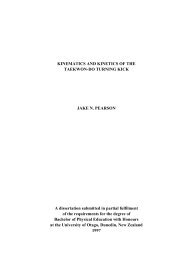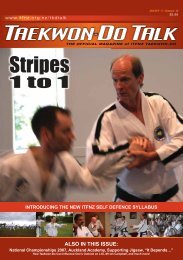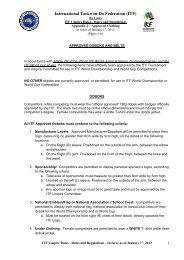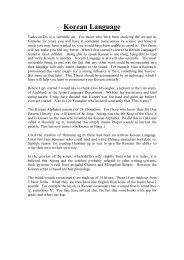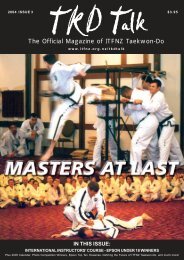REGULARPATTERN DIAGRAM ORIGINSBy Mr Brendan Doogan IV dan, Dragon’s Spirit <strong>Taekwon</strong>-DoTECHNICALThe Chang-Hon set <strong>of</strong> <strong>Taekwon</strong>-Dopatterns practised by the ITFs aresomewhat unique in having meaningattached to the shape the performer traceswith his/her feet.The WTF and other <strong>Taekwon</strong>-Doorganisations, as well as other martialarts, have meanings associated with theirpatterns / tul / poomse / hyung / kata /forms. However, I believe the ITF tul weresome <strong>of</strong> the first to have meaningful patterndiagrams. ‘Kata’ though can translate as‘shape which cuts the ground’ , which mightgive some indication <strong>of</strong> earlier reasons forthe shape <strong>of</strong> the diagrams.Some <strong>of</strong> the pattern diagrams are explicitlylinked to the meaning. Yul-Gok and Toi-Gye are named for rival scholars in thegreat Confucianism vs Neo-Confucianismdivide in 16th century Korea. The patternmeanings both tell us that “the diagramrepresents scholar”. The diagram for Yul-Gok is interesting however, in that there isa pair <strong>of</strong> extra lines at the junction <strong>of</strong> thebase line and vertical line, to represent theperformer’s diagonal movements.Kwang-Gae tul’s diagram “represents theexpansion and recovery <strong>of</strong> lost territory”.In Chinese the figure means ‘earth’ , whichwe can understand as a reference toKwang Gae Toh Wang’s power over land.This pattern meaning seems to contradictthe idea that the Korean peoples neverconducted invasive war, only defensive.Compare with“The history <strong>of</strong>Korea containsnot a singleexample <strong>of</strong> itsmilitary forcesbeing employedfor the invasion<strong>of</strong> its neighboursor for any otherpurpose exceptnational defence” (<strong>Taekwon</strong>-Do, vol 1,p42). Or perhaps ‘expansion’ was a poorlychosen word.Po-Eun tul’s meaning states “the diagramrepresents [Po-Eun’s] unerring loyalty tothe king and country towards the end <strong>of</strong>the Koryo dynasty”. Similar to the use <strong>of</strong>Latin in Europe, Chinese writing was andis widely used in East Asia, including Korea,and this pattern diagram is another <strong>of</strong> thosecharacters. This character has a multitude<strong>of</strong> definitions, but the one that applies hereis ‘one’ – one master; loyalty.The next I dan pattern has quite a similardiagram, this time representing “[Gae-Baek’s] severe and strict military discipline”.The single vertical stroke <strong>of</strong> this character isdifficult to find a meaning for, but I believe itis associated with strong, bright, hot things,about which more below. The diagram iseasily understood from the point <strong>of</strong> view<strong>of</strong> how it is drawn – a single, powerful,uncompromising stroke.The first <strong>of</strong> the three II dan patterns isanother pattern which has a single strokeas its diagram. Eui-Am, real name SonByong-Hi, displayed in<strong>do</strong>mitable spirit“while dedicating himself to the prosperity<strong>of</strong> his nation”. This meaning is resonant withGae-Baek’s.The ultimate pattern <strong>of</strong> the Chang-Honset, in more than one sense, is Tong-Il. Thismeans ‘unification’. I had the pleasure <strong>of</strong>seeing the giant ceremonial bell <strong>of</strong> thesame name in Kyeongju, South Korea.General Choi Hong Hi fervently believed inreunification <strong>of</strong> his divided homeland, andthis pattern in both meaning and diagramrepresents that desire: “The diagramsymbolises the homogenous race”.The pattern diagram for Chon-Ji consists<strong>of</strong> a single vertical stroke crossed by asingle horizontal stroke. These two strokesrepresent the simultaneous clash andbalance <strong>of</strong> opposites: light and dark, maleand female, strong and weak. Yin-yang(um-yang in Korean, in-yo in Japanese)is the meaning <strong>of</strong> this pattern and itsdiagram, whose name “means literally theHeaven the Earth”. The idea is furtherdemonstrated by the low blocks in thefirst half and the middle blocks in thesecond half.Several other patterns have the samediagram: patriotic revolutionaries. general killed by his subordinates. army out <strong>of</strong> Korea. fought the Japanese. fought Japanese pirates.These heroes all defended their countryand were righteous men. There seemsto be a strong correlation between theircharacteristics and the use <strong>of</strong> the Chon-Jitype pattern diagram. This character canalso mean ten or perfect in Chinese.There is a second heroic pattern diagram.It is shaped like a capital I, and can meanlabourer or worker in Chinese:36TAEKWON-DO TALK MAGAZINE
REGULAR to the Silla dynasty. colonial overlord at the cost <strong>of</strong> his ownlife. scholar youths <strong>of</strong> the Silla dynasty. the greatest admiral in history. three king<strong>do</strong>ms <strong>of</strong> ancient Korea.Pattern Se-Jong is named after King Sejong.The diagram is Chinese for king. It looks likea capital I with a third horizontal stroke,halfway between the top and bottom ones.The upper stroke represents heaven. Themiddle stroke represents humanity andthe lower stroke is the earth. A king is aman – the vertical stroke – who can uniteall three realms in harmony.Choong-Jang tul, the second <strong>of</strong> the IIdan patterns has a diagram shaped likean upward pointing tack/pin. The singlehorizontal stroke has a single vertical strokeupward from its centre.There is a Chinese character meaning top,superior or highest, which comes close, butit is not clear how that might relate to thepattern meaning.These people (and one demigod) werefundamental in shaping the essence <strong>of</strong>modern Korea. Dan-gun founded thenation, Won-Hyo gave it a new religion,the Hwa-Rang fought to expand the Sillaking<strong>do</strong>m, which Yoo-Sin succeeded inmelding with the other king<strong>do</strong>ms into onenation. Choong-Moo fought the Japaneseon the water and Joong-Gun fought themon Korean soil.Juche tul has a pattern diagram shaped likethe Chinese character for mountain. Thisis linked to the self reliance philosophy <strong>of</strong>North Korea. “It is said this idea was rootedin Baekdu Mountain which symbolises thespirit <strong>of</strong> the Korean people.” This characteris what gives W shape block its Koreanname, san makgi – san is the Koreanpronunciation <strong>of</strong> the mountain character.Three pattern diagrams I have been unableto find Chinese character explanationsfor. Perhaps readers can write in if theyknow about these shapes. Do-San tul’s andUl-Ji tul’s diagrams are reflections <strong>of</strong> oneanother. Ul-Ji looks like a capital L with anextra horizontal stroke to the left, fromthe top <strong>of</strong> the vertical stroke. Do-Sanhas its horizontal strokes at the bottomleft and top right <strong>of</strong> the vertical stroke,the opposite <strong>of</strong> Ul-Ji. One way <strong>of</strong> lookingat these two characters is as one half <strong>of</strong>a swastika, an ancient religious symbolused in Hinduism, Buddhism and otherfaiths. Seen this way Do-San is half <strong>of</strong> aleft handed swastika and Ul-Ji half <strong>of</strong> theright handed version. A scholar <strong>of</strong> Chinesecalligraphy and Buddhism would have thebest qualifications to confirm this theory.I hope that this article has been <strong>of</strong> someinterest to the reader, and shed a littlelight on one <strong>of</strong> the lesser known areas <strong>of</strong>our Art.Brendan Doogan is a IV dan black belt with<strong>International</strong> <strong>Taekwon</strong>-Do, an <strong>International</strong>Instructor and Umpire.A six week visit to Korea in 2007 providedMr Doogan with information and ideas thatled to this article.ISSUE TWO, 201237



